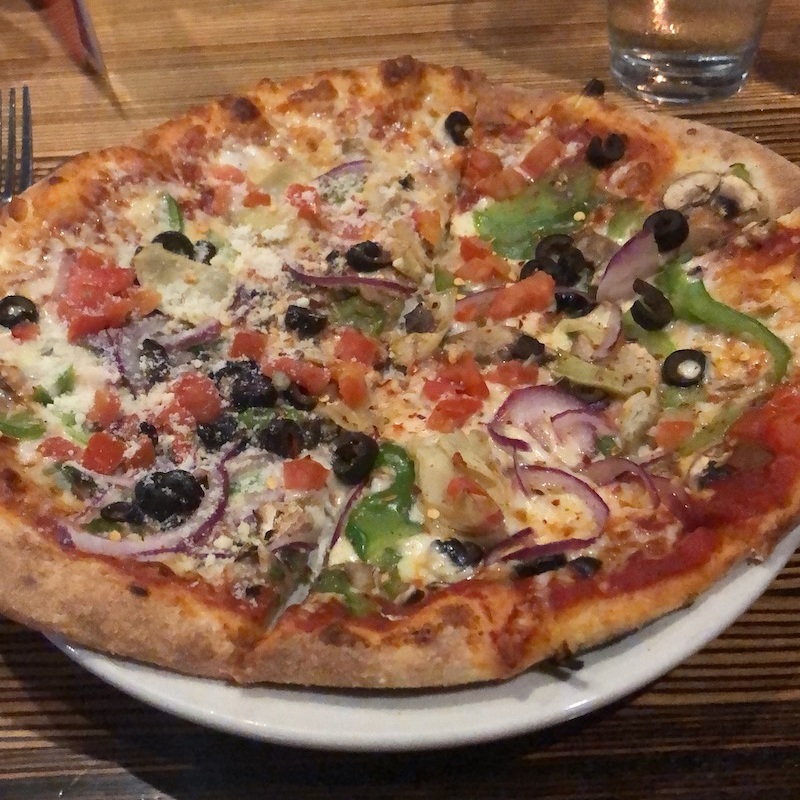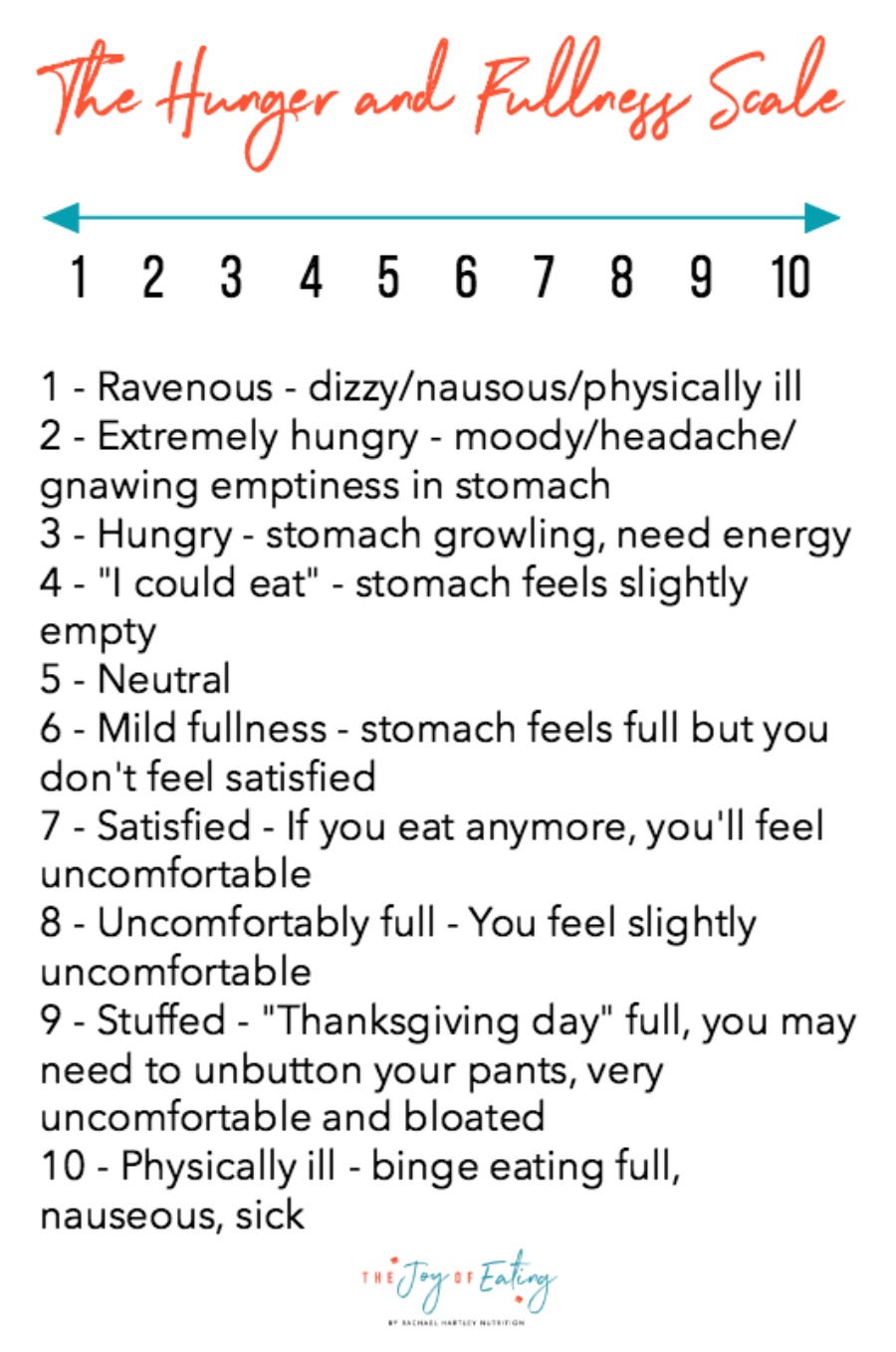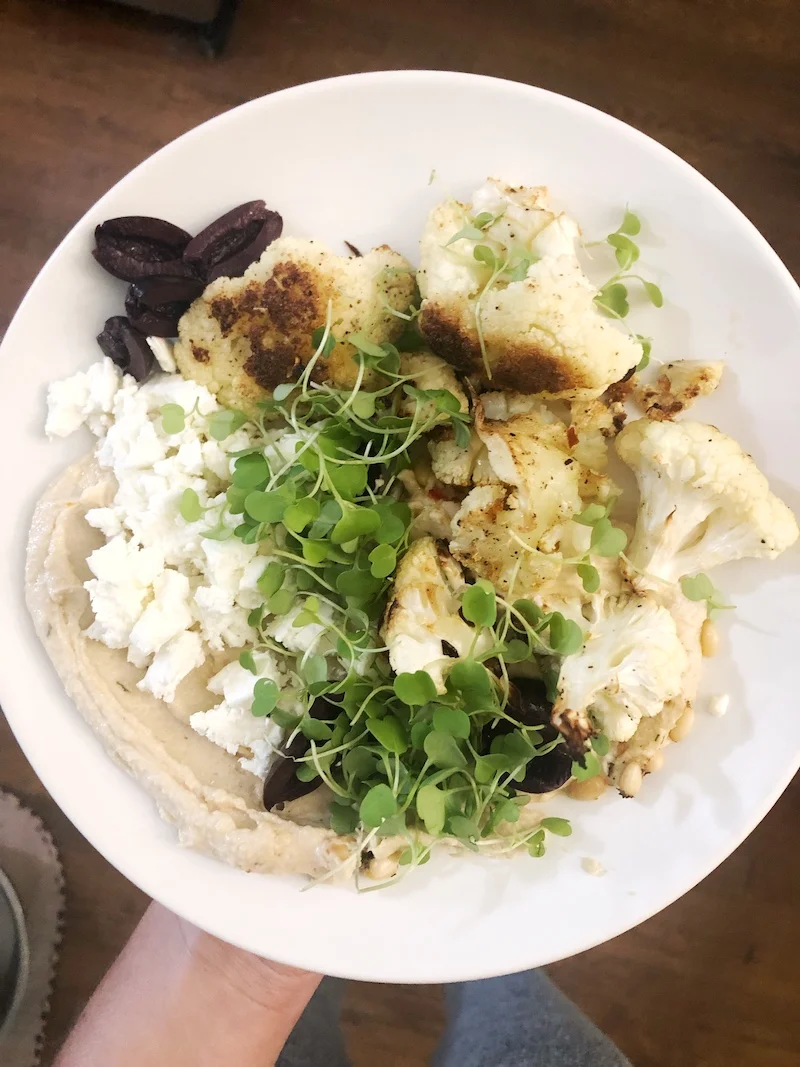How to Use the Hunger Fullness Scale in Intuitive Eating
Years of yo-yo dieting and disordered eating can get you out of touch with internal cues, like your body's hunger and fullness signals. Learn how to use the hunger fullness scale in intuitive eating, a tool that can help you can back in touch with when and how much to eat.
One of the lies diet culture sells is the idea that left to your own devices, you wouldn’t be able to manage eating. Without calories or points or macros or a list of good and bad foods to keep things in check, you would just gorge yourself silly on food. They tell you that you can’t trust yourself, so you need their external rules to keep under control.
Of course, then when you eventually break the rules and eat the food you’ve been restricting, it inevitably feels out of control. That out of control feeling reinforces the need for rules, despite the fact that it is a totally predictable outcome of restriction - not a lack of willpower or faulty personal trait.
In reality, you don’t need calorie counting, points, macro budgeting or any other diet to manage eating. You already have all the skills and tools you need to eat the right amount of food for you. One of those tools are your hunger and fullness cues.
Hunger Fullness Cues
This may sound really obvious, but your hunger and fullness cues are there for a reason - to tell you approximately when to start eating and when to stop eating. You brain has sort of a built in My Fitness Pal called the hypothalamus, which can sense energy intake and energy stores, and regulates appetite in response to your energy needs. Just like the urge to pee means you need to urinate, a dry mouth tells you to drink water, and heavy eyes tell you to sleep (or drink a coffee 😬), hunger cues sent by your hypothalamus mean you need food. It really is as simple as that.
What’s cool about hunger and fullness cues is that they can adapt to your changing energy needs. Diets make it seem like there is a very exact amount of calories that your body needs, but in reality, your metabolism changes from day to day based on a variety of factors - hormonal changes, physical activity, how much you ate, sleep, etc. Listening to your hunger and fullness cues can help you appropriately respond to these changing needs.
Was feeling pretty uncomfortably hungry by the time my pizza arrived (around a 2) because it took awhile to get a table, so I ate a bit more than usual to feel satisfied. But that’s OK - it’s not overeating it’s eating enough to appropriately respond to my level of hunger!
How Dieting Impacts Hunger and Fullness Cues
If you’re reading this and thinking, “Rachael, what on earth are you talking about with this hunger/fullness cue nonsense” don’t worry, you’re not alone. Dieting and disordered eating (not to mention stress, digestive conditions, and even some medications) can interfere with your connection to hunger and fullness cues. Restriction teaches you to ignore those first signs of hunger, telling you things like just chew gum or drink water or go for a walk instead! When you finally do experience hunger, it’s an extreme and uncomfortable sensation. What happens when you eat when you’re overly hungry? You’ll likely blow well past satisfaction and end up feeling stuffed. Through repeated cycles of restriction and overeating, hunger and fullness become extreme sensations.
Over time, you can start to lose touch with those more subtle signs of hunger. Fullness can get blurry too. While some people learn fullness as an extreme sensation, others may learn to stop eating when they’re no longer hungry, even if they aren’t satisfied. Yet lack of hunger isn’t the same thing as eating enough. Dieting chips away at this innate ability to respond to hunger and fullness cues and turns these physical sensations into something confusing, shameful, and hard.
Had a late breakfast after camping outside of Brevard, but since we were meeting up with my parents for lunch in a little over an hour, ate this (amazing!) pimento cheese scone that got me to a 6ish on the hunger fullness scale, vs a more filling breakfast sandwich. I wanted to leave room for yummy apps at the restaurant we were meeting at, but I also didn’t want to be ravenous when I got there!
Getting Back in Touch with Hunger and Fullness Cues
The good news is that you can get back in touch with hunger and fullness cues, even if it feels like they’re “broken” from dieting and disordered eating. I like to use the analogy of reestablishing a friendship. Imagine your hunger and fullness cues are a friend who has been calling and calling you, but you never pick up the phone. They decided you’re a crap friend and stopped calling. Now it’s up to you to be the one to pick up the phone and reestablish the friendship.
In this analogy, reestablishing the friendship means feeding your body adequately throughout the day. As a general guideline (not a rule), that means eating a satisfying meal or snack every 3-4ish hours. If you’re not sure what that might look like, an intuitive eating dietitian can help, or check out this post I wrote on how to plan a satisfying meal and this post on snacks.
It also means checking in on your hunger and fullness cues. Even at first if they’re a little wonky, the simple act of tuning into what your body feels like at various points through the day will help you better understand what different levels of hunger and fullness are like for you. One way you can do this is with the hunger and fullness scale.
My current go-to when I’m feeling snack hungry (4ish) at work.
How to Use the Hunger Fullness Scale in Intuitive Eating
The hunger fullness scale in intuitive eating is a tool that’s used to better understand different levels of hunger and fullness, and how to appropriately respond to those levels. It’s a scale of 1-10, where each number correlates to a different level of hunger or fullness. Below is the hunger fullness scale I use with my clients.
It’s really simple to use! Just take a second to evaluate how you feel, and pick the number on the scale that most fits that. Keep in mind that hunger and fullness isn’t only felt in the stomach - fatigue, anxiety, shakiness, headaches, etc are all signs of hunger, and reduced desire to eat, not thinking about food, or feeling more energized can be a sign of fullness.
Different levels feel different for different people, but below are some things I frequently hear from my clients about the various numbers on the scale:
10 - binge level of fullness, so full that you feel physically sick
9 - Thanksgiving day full, uncomfortably full, food coma, feel like you have to change into sweatpants
8 - slightly uncomfortably full, how you feel leaving a good restaurant meal, slightly distended roundness/fullness to your stomach
7 - satisfied, but not stuffed, stomach feels satiated and there is a roundness to it, but it’s not physically uncomfortable
6 - filling up, but not full, stomach is no longer empty and is starting to feel more full, but you still desire food
5 - neutral, how you feel a couple hours after a satisfying meal
4 - thinking about food, snack hunger, energy levels slightly low, slight empty feeling to stomach but no pangs
3 - meal hungry, stomach feels empty but not uncomfortably so, maybe some very slight gnawing but nothing too strong, low energy, thinking a lot about food
2 - uncomfortably hungry, hangry, starting to get shaky/dizzy, slight headache, pang/significant gnawing
1 - very uncomfortable hunger, dizzy/faint, severe headache, nauseous, so hungry you’re not hungry
When I’m teaching clients how to use the hunger fullness scale, I encourage them to think of it like a multiple choice question you don’t know the answer to. Remember, the goal isn’t that you are able to perfectly identify that you are at 3.47 or something like that. The scale is a tool for tuning in and getting back in touch with those cues. So if you’re not sure what number you’re at, just rule out the ones you know don’t fit, then go with your gut instinct for what remains .
Ideally, you should start eating at a 3 or 4. Because you’re not at an uncomfortable level of hunger, and the blood sugar in the brain isn’t too low, you can still make rational, intentional choices about food. But life happens, and sometimes you’ll end up unprepared to adequately honor your hunger, and find yourself at a 1 or 2. Your brain might be going into panic mode because we still have primitive brains that interpret hunger as a threat to survival (i.e. starvation), so as best as you can, try and remind yourself that even though it feels incredibly uncomfortable, you can still slow down and eat intentionally.
This roasted cauliflower hummus plate with pita was a really satisfying eating experience. I started eating around a 3, which was easy to do after a busy day because it was a fast meal to make. I ended up feeling around a 7.
There’s no right or wrong with where to stop, but it’s smart to aim for 7 most of the time. That’s a level that will leave you feeling satisfied and energized until your next meal or snack. That said, there may be times where eating till an 8 feels more appropriate, like going out to eat, or if because of your schedule, you have to go awhile before eating again. Or, you might just miss the mark and end up feeling overly full and that’s OK too! Other times, a 6 might feel better for you, like if you know you want to save room for dessert, or if your stomach feels a little wonky. I usually eat to a 6 at breakfast because my stomach is sometimes a bit unsettled in the morning, and a 7 feels more like an 8 to me, if that makes sense. Again, sometimes you might just miss the mark and wish you got more food - that’s OK too! Just get a snack earlier!
If the numbers feel overwhelming for you, drop them and just focus on uncomfortable/comfortable hunger, and comfortable/uncomfortable fullness.
Had a really yummy meal of fish and veggies at a fancy restaurant, but I was only like a 5-6, because, you know, we need carbs. This dessert at Milkbar brought me to a 7.
When to Use the Hunger Fullness Scale
Again, there’s no rules here! Just a tool that’s available for you when you need it. But that said, I’ve found for clients who are trying to reestablish cues, it can be helpful to check in throughout the day, not just when you’re eating. That way you’re likely to catch hunger at those more subtle levels, not just checking in immediately before eating. Some of my clients have tried checking in at transitions (for example, students changing classes). Others have set alarms on their phone as a reminder. Just know that you’ll totally forget some days and that’s OK!
Getting back in touch with fullness, it can be helpful to tune into the changing sensations while you eat. What would it be like to check in every so often during a meal and see how your hunger fullness levels have changed? Consider checking in with a bite in the beginning, middle and end of the meal.
This tofu cobb salad was another yummy one that brought me to a 7. I had a pretty satisfying snack that had carbs about an hour, hour and a half before eating, so I was around a 4 when I started to eat. That’s why a lighter salad that might normally have left me wanting more, actually satisfied.
The Hunger Fullness Scale is a Tool, Not a Rule
I know I’ve said this already, but it bears repeating, the hunger fullness scale in intuitive eating is not a rule, but rather a tool. For some people, it can be a helpful intro into intuitive eating. For others, an early focus on hunger and fullness can feel like a diet. If that’s you, consider focusing on honoring hunger first before thinking about fullness, or focus on other principles of intuitive eating.
Had roasted winter squash, sauteed spinach, goat cheese, and hazelnuts (yum!) topped with a fried egg and goat cheese for dinner. I was still at a 6 after eating this plate so I got seconds.
I hope this post has been a helpful intro for you! If you’re still feeling overwhelmed by hunger and fullness, keep in mind this is just an intro, and the hunger fullness scale is just one tool. If you’re interested in learning more about hunger, fullness, and intuitive eating, we work with clients throughout the US providing intuitive eating coaching. Reach out to see if it’s a good fit for you and your needs!
If this post on the how to use the hunger and fullness scale was helpful, follow my intuitive eating Pinterest board for more support.
This post on How to Use the Hunger Fullness Scale in Intuitive Eating was originally published Feb 2015 and has been updated to give you the best content possible.













